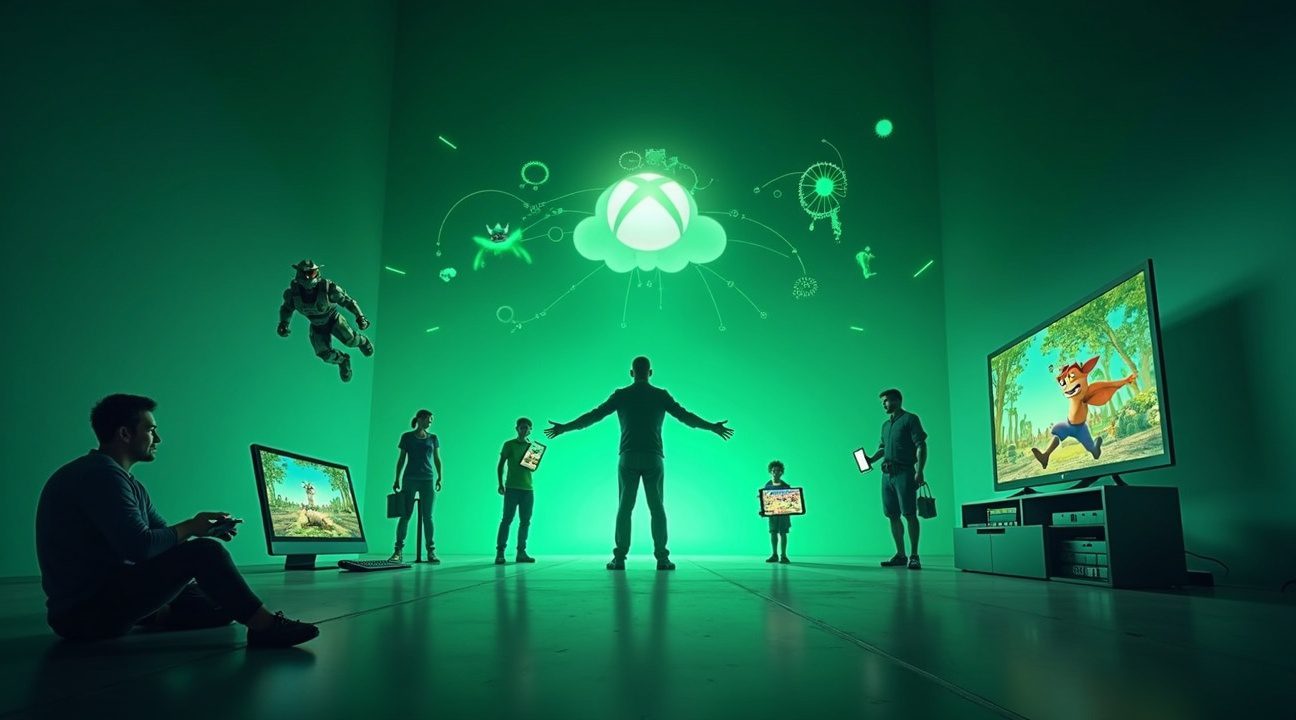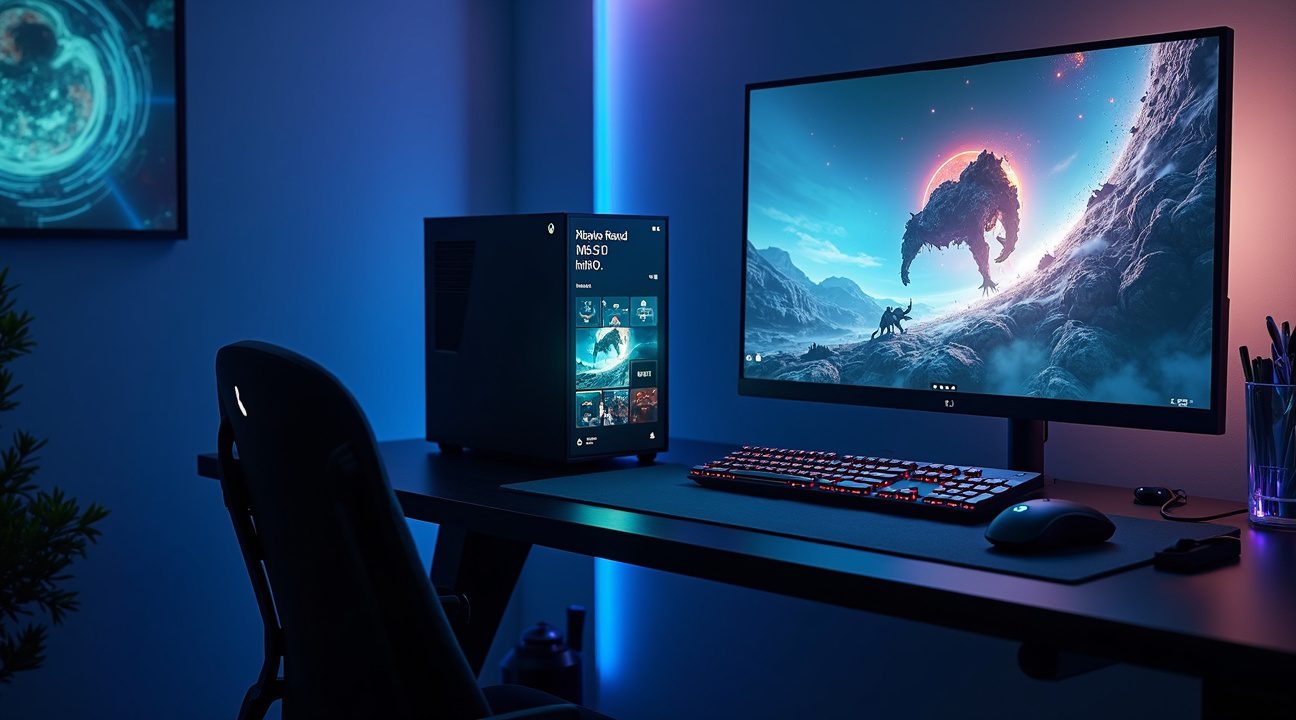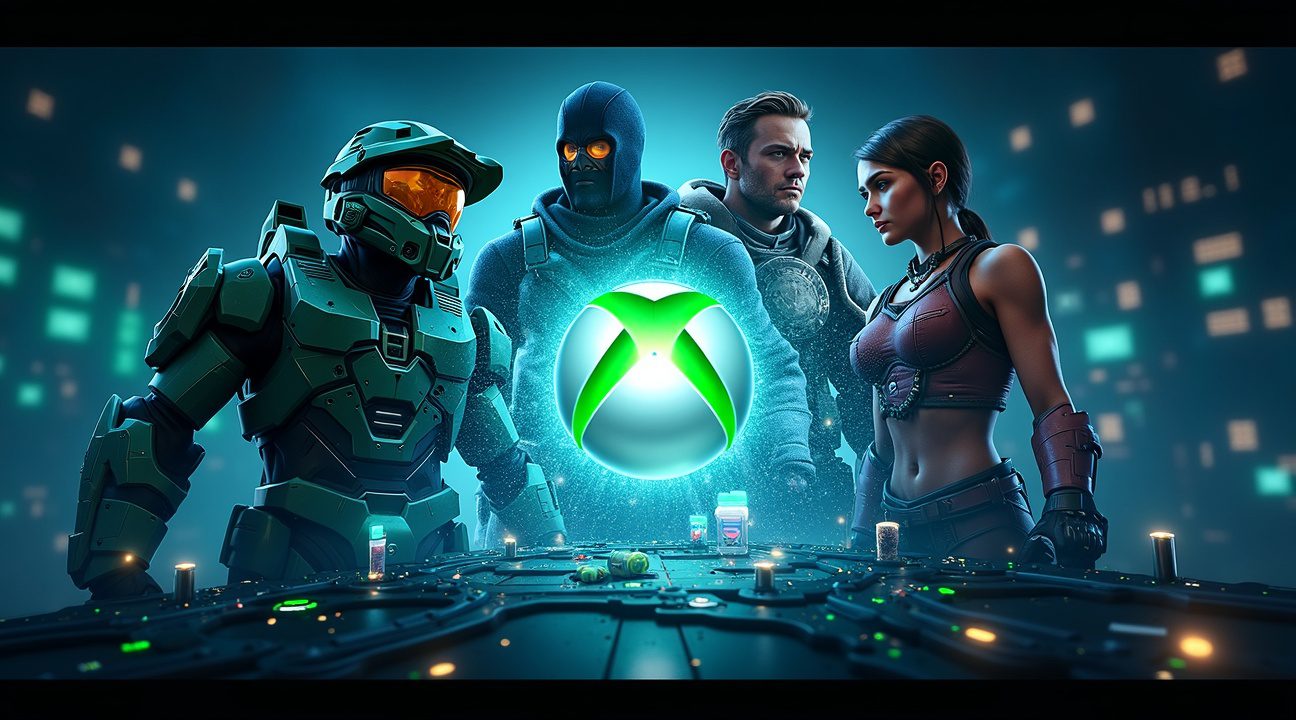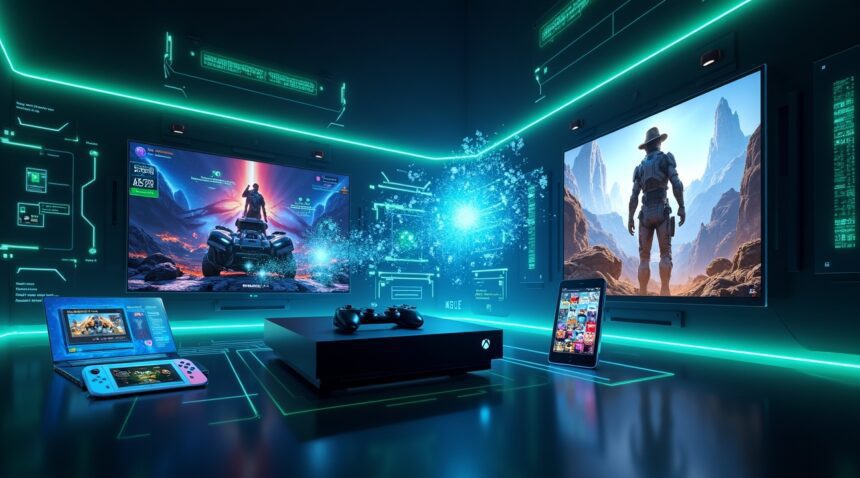Microsoft CEO Satya Nadella has unveiled a revolutionary vision for Xbox games, declaring they will appear on every platform instead of staying locked to Microsoft’s ecosystem.
This strategic pivot marks a complete break from traditional console exclusivity models. Microsoft now positions itself as a content provider that values reach over hardware limitations through massive acquisitions like Activision Blizzard.
Key Takeaways
- Microsoft has become the world’s largest game publisher through the Activision Blizzard acquisition, bringing franchises like Call of Duty, World of Warcraft, and Halo under one umbrella.
- Xbox games will launch across competing platforms, with Halo coming to PlayStation for the first time and titles like Indiana Jones arriving on Nintendo Switch 2.
- The next-generation Xbox console will integrate Windows 11 and support third-party storefronts like Steam and Epic Games, creating a PC-console hybrid platform.
- Microsoft views TikTok and social media platforms as greater competition than traditional gaming consoles, reflecting the battle for user attention spans.
- Xbox Game Pass subscription service provides the financial foundation for this multiplatform strategy, generating steady revenue that enables wide game distribution without relying solely on hardware sales.
Satya Nadella Declares Xbox Games Will Be ‘Everywhere, On Every Platform’
Microsoft CEO Satya Nadella has articulated a bold vision that positions Xbox games as universally accessible entertainment, available across consoles, PCs, mobile devices, cloud gaming services, and smart TVs. This comprehensive approach represents a fundamental shift from traditional gaming exclusivity models that have defined the industry for decades.
Microsoft’s Game Publishing Dominance Through Strategic Acquisitions
The Microsoft Activision deal has transformed the company into the world’s largest game publisher as of Q4 2025. This massive acquisition brings iconic franchises like Call of Duty, World of Warcraft, Halo, and Candy Crush under Microsoft’s umbrella, creating an impressive intellectual property portfolio that supports their multiplatform strategy.
Nadella draws parallels between Xbox’s new direction and Microsoft Office’s successful cross-platform deployment. Just as Office functions seamlessly across different operating systems and devices, Xbox games will transcend traditional hardware boundaries. This analogy illustrates how Microsoft views gaming as a service rather than a hardware-dependent experience.
Financial Foundation Through Xbox Game Pass
Xbox Game Pass serves as the financial backbone for this ambitious multiplatform strategy. The subscription service has attracted tens of millions of users, generating steady revenue streams that enable Microsoft to distribute games widely without relying solely on hardware sales. This subscription model provides the financial stability necessary to support game development and distribution across competing platforms.
I’ve observed how this approach challenges conventional wisdom about platform exclusivity. Rather than restricting Call of Duty availability to Xbox consoles, Microsoft has committed to maintaining cross-platform access. This decision reflects Nadella’s broader philosophy of breaking down barriers that have historically limited gaming accessibility.
The strategic shift extends beyond major franchises. Even beloved titles like Crash Bandicoot and Spyro face uncertain exclusivity arrangements as Microsoft prioritizes reach over restriction. This transformation signals a new era where gaming experiences aren’t confined to specific hardware ecosystems.
Microsoft’s approach emphasizes innovation through accessibility rather than through exclusivity. By making Xbox games available everywhere, the company positions itself to capture revenue from the entire gaming market rather than just Xbox console owners. This strategy acknowledges that modern gamers expect flexibility in how and where they access their favorite titles.

Halo Comes to PlayStation as Microsoft Breaks Down Exclusive Barriers
Microsoft made an unprecedented announcement in late 2025 that sent shockwaves through the gaming community. For the first time in franchise history, Halo will launch on PlayStation platforms, marking a dramatic departure from decades of Xbox exclusivity. This groundbreaking decision represents Microsoft’s commitment to reaching players wherever they choose to game, regardless of their preferred console.
Major Franchises Cross Platform Boundaries
The company’s cross-platform strategy extends far beyond Master Chief’s adventures. Bethesda titles under Microsoft’s ownership are embracing this new approach with impressive scope. Indiana Jones and the Great Circle will arrive on Nintendo’s upcoming Switch 2 in 2026, bringing the beloved archaeologist’s latest adventure to portable gaming. Fallout 4: Anniversary Edition follows suit, confirming its release on the same platform during the same timeframe.
This strategic shift demonstrates Microsoft’s recognition that exclusive content no longer drives hardware sales as effectively as it once did. Players increasingly value game accessibility over console loyalty, and Microsoft appears ready to capitalize on this trend. The Microsoft Activision deal previously hinted at this direction, suggesting major changes in how gaming giants approach platform exclusivity.
Industry Transformation Beyond Console Wars
Microsoft’s decision aligns with broader industry movements that prioritize audience expansion over hardware competition. The company’s leadership clearly believes that maximizing game reach generates more revenue than restricting access to drive console sales. This philosophy directly challenges traditional business models that relied heavily on exclusive titles to differentiate gaming platforms.
The gaming landscape has evolved significantly, with subscription services and cloud gaming reducing the importance of owning specific hardware. Microsoft’s Game Pass service already demonstrates how content accessibility can drive engagement across multiple devices. By extending this approach to rival platforms, the company positions itself as a content provider rather than just a hardware manufacturer.
This transformation reflects changing consumer expectations and market realities. Players want flexibility in how and where they access their favorite games, and Microsoft’s willingness to accommodate these preferences could reshape competitive dynamics throughout the industry. The move signals confidence in Microsoft’s content quality and suggests the company believes its games can succeed on merit alone, regardless of platform exclusivity.
Next-Gen Xbox Becomes PC-Console Hybrid with Windows 11 Integration
Microsoft’s upcoming Xbox console represents a fundamental shift in gaming hardware design, with plans to integrate Windows 11 directly into the system. This approach transforms the traditional console model into something entirely different—a hybrid platform that combines the accessibility of console gaming with the versatility of PC gaming.
Open Platform Gaming Experience
The new Xbox hardware will support third-party storefronts including Steam and Epic Games, breaking down the traditional barriers between console and PC gaming. This unprecedented move allows players to access their existing game libraries from multiple platforms without needing separate devices. I see this as Microsoft’s answer to the fragmented gaming landscape, where players often need multiple systems to access all their favorite titles.
The integration goes beyond simple compatibility. Microsoft is positioning this hybrid console as a true alternative to traditional gaming PCs, but with the plug-and-play simplicity that console users expect. This strategy aligns with broader industry trends, particularly following major acquisitions that have reshaped platform exclusivity discussions.
AI-Powered Visual Enhancement Technology
Microsoft’s investment in advanced AI technologies will debut with NPU-powered Auto Super Resolution upscaling in the 2026 hardware release. This technology promises real-time visual enhancement without requiring developers to implement specific optimizations. The AI-driven approach automatically improves game visuals, potentially making older titles look significantly better on the new hardware.
The NPU integration represents a significant technical achievement, as it offloads processing from the main GPU while delivering tangible visual improvements. Players can expect enhanced frame rates and resolution scaling across their entire game library, regardless of whether titles were originally designed for these capabilities.
This unified approach directly challenges competitors who maintain stricter ecosystem boundaries. Microsoft’s strategy acknowledges that modern gamers want access to content across multiple platforms without compromising on performance or convenience. The Microsoft Activision deal has already demonstrated the company’s commitment to cross-platform availability, and this hardware evolution continues that philosophy.
The hybrid console concept addresses a key pain point for gamers who previously needed to choose between console simplicity and PC flexibility. By eliminating this choice, Microsoft creates a compelling value proposition that could redefine what consumers expect from gaming hardware in the next generation.

Microsoft Says TikTok, Not PlayStation, Is Now Xbox’s Real Competition
Microsoft CEO Satya Nadella has fundamentally shifted the conversation about Xbox’s competition, declaring that platforms like TikTok now pose a greater threat than traditional gaming consoles. This statement represents a dramatic departure from the console wars mindset that has dominated the gaming industry for decades.
The company’s executives recognize that today’s entertainment landscape extends far beyond gaming hardware. Short-form content platforms capture user attention for hours daily, directly competing with gaming sessions. TikTok’s algorithm-driven engagement keeps users scrolling endlessly, creating a new battlefield for Microsoft to consider.
Redefining the Entertainment Competition
This strategic pivot acknowledges how digital consumption patterns have evolved. Gaming companies no longer compete solely against other gaming platforms—they fight for mindshare against social media, streaming services, and bite-sized content creators. The Microsoft-Activision deal demonstrates this broader approach to content acquisition and distribution.
Microsoft’s higher profit margins from its diversified business model enable significant investment in research and development. The company can experiment with interactive content formats that blur the lines between gaming and social media engagement. This financial advantage allows Xbox to explore innovative approaches that pure gaming companies might struggle to fund.
Strategic Implications for Gaming Innovation
The shift influences how Microsoft approaches game development and platform features. Interactive experiences that incorporate social sharing, user-generated content, and real-time engagement become priorities. Games like Call of Duty already demonstrate how social features drive sustained engagement beyond traditional gameplay.
Microsoft’s perspective reflects broader industry trends where platforms compete for daily active time rather than hardware sales. The company invests in cloud gaming, cross-platform connectivity, and social features that keep players engaged across multiple devices. This approach contrasts sharply with console-exclusive strategies that limit audience reach.
Understanding TikTok as competition means Microsoft must create compelling reasons for users to choose gaming over endless scrolling. The company develops features that satisfy the same psychological triggers—immediate gratification, social validation, and continuous content discovery. Game Pass subscriptions benefit from this mindset, offering constant variety that mirrors social media’s endless feed concept.
This competitive framework suggests that future Xbox innovations will prioritize:
- Accessibility
- Social connectivity
- Bite-sized gaming experiences
Microsoft positions itself not just as a gaming company, but as an entertainment platform competing for precious attention spans in an increasingly crowded digital ecosystem.

Activision Blizzard Acquisition Makes Microsoft Gaming’s Biggest Publisher
The acquisition of Activision Blizzard has positioned Microsoft as the largest game publisher globally, fundamentally reshaping the competitive landscape of the gaming industry. This strategic move surpassed traditional industry leaders and established Microsoft’s dominance across multiple gaming segments.
The deal brought an impressive collection of high-value intellectual properties into Microsoft’s portfolio. Call of Duty stands as the crown jewel, representing one of the most successful franchises in gaming history. World of Warcraft continues to define the MMORPG genre with millions of active subscribers worldwide. Diablo and Overwatch add depth to Microsoft’s action and competitive gaming offerings, while Halo strengthens the company’s first-party exclusives. Even mobile gaming receives a boost through Candy Crush, which maintains massive popularity across casual gaming audiences.
Strategic Portfolio Expansion
This expanded intellectual property base creates unprecedented opportunities for Microsoft’s multiplatform strategy. The company can now deploy content across Xbox consoles, PC platforms, and cloud services with greater flexibility than ever before. Each franchise brings its own dedicated fanbase, allowing Microsoft to reach diverse gaming communities that previously remained outside its direct influence.
The acquisition enables Microsoft to leverage these properties across various distribution channels simultaneously. Cloud gaming benefits from having established franchises that attract subscribers, while traditional console sales receive support from exclusive content and early access opportunities. PC gaming expands through Game Pass integration and direct platform releases.
Market Leadership and Publishing Flexibility
Microsoft’s new position as the industry’s largest publisher creates significant advantages in market negotiations and content distribution. The company can now influence platform policies, secure favorable publishing terms, and establish new industry standards for cross-platform gaming experiences. This leadership position strengthens Microsoft’s ability to implement its vision of gaming accessibility across all devices.
The acquisition provides enhanced flexibility for publishing initiatives across multiple platforms. Microsoft can strategically release titles where they generate maximum impact while maintaining exclusive content for its own ecosystem when appropriate. Microsoft’s Activision deal demonstrates the company’s commitment to expanding its reach rather than limiting content to specific platforms.
Publishers traditionally face challenges balancing exclusive content with broader market reach. Microsoft’s approach emphasizes maximizing player engagement across all available platforms rather than restricting access to drive hardware sales. This philosophy aligns with current industry trends favoring service-based gaming models over traditional console exclusivity.
The expanded portfolio allows Microsoft to experiment with different distribution strategies for various franchises. Some titles benefit from day-one Game Pass availability, while others might follow traditional retail release patterns to maximize revenue. Call of Duty’s continued PlayStation availability exemplifies this flexible approach to content distribution.
Microsoft’s position as the largest game publisher fundamentally changes how the company approaches platform relationships. Instead of viewing competitors as adversaries, Microsoft can treat them as potential distribution partners for its expanding catalog of games. This shift reflects broader industry movement away from platform wars toward collaborative content sharing.
The acquisition’s impact extends beyond immediate market share gains. Microsoft gains access to established development teams, proven game engines, and existing player communities that would require years to build organically. These assets accelerate the company’s ability to deliver consistent content across all gaming platforms while maintaining quality standards that players expect from premium franchises.
Cloud gaming services particularly benefit from this expanded content library. Established franchises provide immediate value propositions for subscription services, reducing the time needed to build compelling game catalogs. PlayStation Network’s Steam connectivity shows how platform boundaries continue to blur as companies prioritize player convenience over exclusive content restrictions.

Sources:
Windows Central: “Microsoft CEO Satya Nadella is ‘looking forward’ to the next Xbox”
VideoGamesChronicle: “Microsoft’s CEO agrees Xbox’s competition isn’t other gaming platforms, it’s TikTok”
Nintendo Life: “Microsoft On Its Gaming Business Going Forward: ‘We Want To Be Everywhere'”
VGChartz: “Microsoft CEO on Xbox Multiplatform Strategy: ‘We’re Going to be Everywhere, On Every Platform'”
PC Gamer: “The best way to innovate in gaming ‘is to have good margins,’ says Microsoft CEO Satya Nadella”
ENCentral: “Microsoft is planning an innovative future for Xbox and PC gaming”


